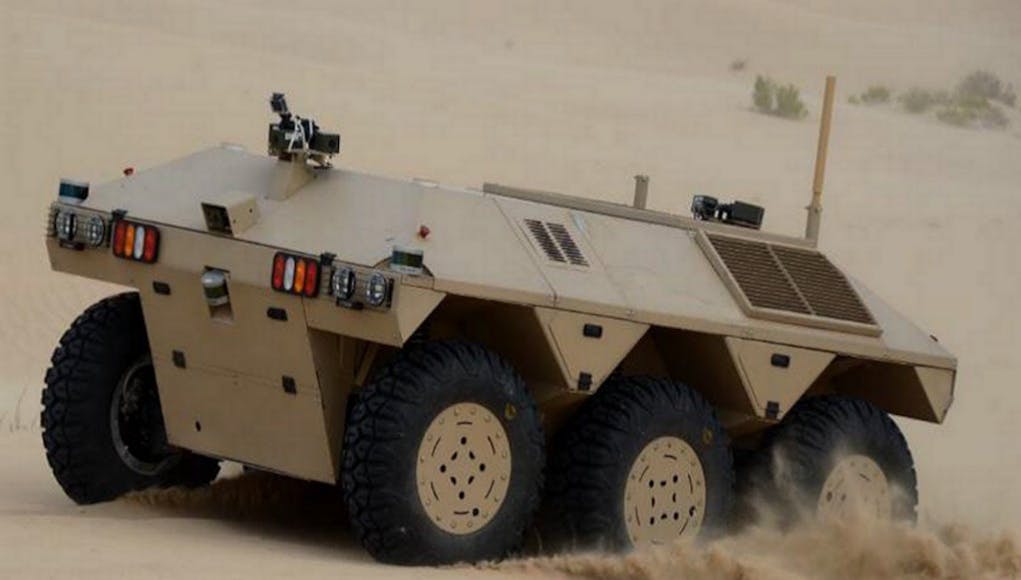Futuristic drones and unmanned robots with autonomous ‘deliver to order’ capability could provide front-line military logistics support say the MoD.
In a new cross-government collaboration, the Ministry of Defence (MOD), the Department for International Development (DFID) and UK Research and Innovation (UKRI) are working together on turning cutting-edge designs for drones and robots into reality.
Experts from the Defence Science and Technology Laboratory (Dstl) are leading the partnership as part of MOD’s Innovation Autonomy Challenge, with joint competition funding from MOD, DFID and UKRI being placed through the Defence and Security Accelerator (DASA).
This is the second phase of the competition say the MoD, which will build prototypes for initial demonstration this year, and is worth a total of £3.8m over the next 12 months. Four of the five successful organisations are British-led, with a wide range of sub-contractors from small and medium enterprises, industry and academia.
Winning systems concepts include autonomous hoverbikes, powered paragliders and other unmanned air vehicles, operating alongside self-driving ground vehicles to deliver supplies across difficult, and potentially contested, terrain.

Defence Secretary Gavin Williamson said:
“Defence makes an unrivalled investment in science and technology, creating thousands of highly-skilled jobs and brilliant career opportunities, generating billions for the UK economy.
This Autonomous Last Mile competition has seen next-generation concepts from unmanned hoverbikes to powered paragliders come to life.
And they could be saving troops’ lives on the battlefield in years to come. I congratulate all those involved in the competition as they ensure our military remain ahead of our adversaries.”
Phase 2 has selected 5 bids, led by Animal Dynamics Ltd, Barnard Microsystems Ltd, Fleetonomy, HORIBA MIRA, and Qinetiq, to build prototypes systems for initial testing and evaluation this autumn:
- Animal Dynamics with a system featuring novel autonomous powered paragliders;
- Barnard Microsystems Ltd with Cranfield University developing a vertical take-off and landing unmanned air vehicle-based system;
- Fleetonomy with Thales, Thesigers, Avartek & Callen Lenz to provide a system to demonstrate autonomous networked unmanned deliveries in the urban and other environments;
- Horiba Mira with Frazer Nash Consultancy featuring a highly autonomous all-terrain unmanned ground vehicle using artificial intelligence to provide GPS-denied navigation, advanced terrain perception and object recognition;
- QinetiQ with Hull University, Malloy Aeronautics, MilRem Robotics, Roke Manor Research, Oxbotica, IQHQ Ltd & Aberystwyth University offering an integrated highly-automated logistic system, featuring autonomous hoverbikes and advanced unmanned ground vehicles.
Peter Stockel, Dstl’s lead for the Innovation Autonomy Challenge, said:
“We’re particularly pleased that we’re able to take the next step on this important journey in partnership with DFID and UKRI, as part of our innovation initiative. Working together we can collectively make the best use of the resources available for the most promising proposals and this is good joining together of important government interests and investment. It increases our options across similar requirements and offers a broader range of potential routes to market for this rapidly developing technology area where the UK has world-class expertise and innovation.”
For future frontline military operations, the technology could reduce risk to soldiers by removing them from the hazards of frontline logistics resupply and improving the pace of operations.













The sooner the better. Why send troops down roadways where you believe there is a high risk of IAD’s? Using any form of unmanned equipment into danger zones is long overdue, especially in urban fighting zones. I would like to see troops deployed only when all options are exhausted. Such technology won’t replace feet on the ground, but there could be fewer but highly trained and specialized forces going forward.
Meanwhile in the real world the British army has still not declared Watchkeeper operational, is scrapping Desert Hawk 3 and disbanding one of its UAV regiments.
Cuts, cuts and more cuts.
That’s not a new cut is it Mike? You refer to 32 RA flying DH3? That was announced in 2016.
You can add Black Hornet to that too.
That is correct Daniele.
My point is on one hand they are saying we are going to rapidly expanding our future drone inventory and on the other they are cutting it.
The personnel from 32 regiment will thankly not be made redundant as they will posted to gun and missile artillery units. But the expertise, skills and experience built up over the past 15 years on UAS systems by that unit will be lost.
If and when new UAS systems are introduced then the skills will have to be relearned all over again costing both time and money.
Agree. That behaviour is typical of the MoD sadly.
Apparently there is a turf war underway at the moment over who will field a DH3 replacement, the RAC or the RA. Neither want it!
I’d give the UAV mission to the AAC or the Light Cavalry Regiments of the RAC. The RA need gun regiments! There are so few left. 2 AS90 Regiments. 2 Light gun Regiments for 2 Strike Brigades, and its is unconfirmed if they will even keep their guns. 2 Light Gun Regiments for 16AA and 3 Cdo, plus a couple of reserve Light Gun Regiments.
A deplorable situation for the RA to be in.
The planning for equipment seems to suffer from a high v low compromise. It seems the MOD and policiticans like announcing big purchases and so the money appears to go that way rather than towards the more low end where it would actually make the biggest impact.